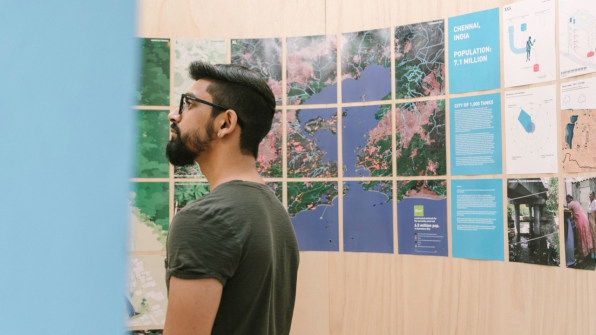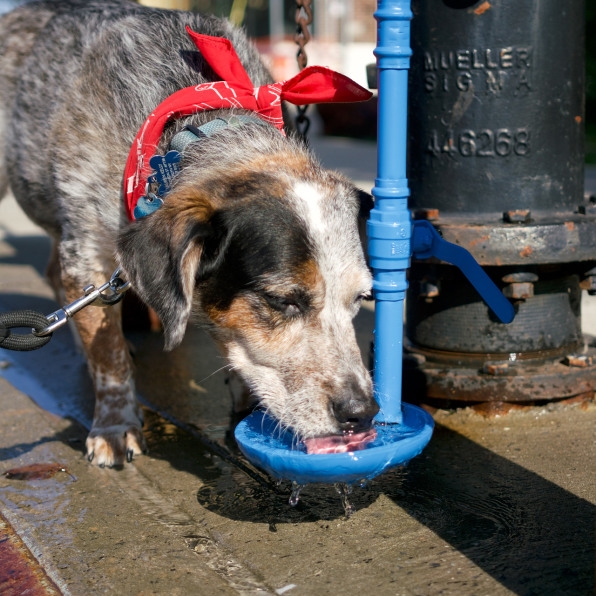New York City may be home of the Pizza Rat and one of the stinkiest waste infrastructure problems in the country, but it’s also one of only five major U.S. cities with water that’s drinkable straight from the tap, and clean enough to forgo additional filtration. It’s a rare urban asset, one that inspired architect Tei Carpenter and designer Chris Woebken to reimagine the everyday fire hydrant as something that could be used more broadly.
Through a series of playful, bright blue fixtures and simple, easily attached extensions, the duo transform fire hydrants into public drinking fountains and sprinklers that they hope to have installed around the city. In one of three variants of the concept, the hydrant is retrofitted to be a water fountain for all, with taps for humans, pets, and even birds; in another, it serves as a fill station for water bottles, addressing the mounting plastic waste crisis. In the third, the designers cleverly attach a sprinkler head to the hydrant, playfully addressing the way they’re already used by locals in the summer, cracked open during block parties or sweltering afternoons as a respite from the heat.
While Carpenter and Woebken’s New Public Hydrant project is currently a proposed concept, the designers make a good case for its viability. And in fact, the project itself was largely inspired by the NYC Department of Environmental Protection’s recent Water-On-the-Go pilot program, which has installed pop-up public fountains around the city to urge residents to drink from the city’s taps, rather than loading up on plastic bottles.
“There’s an interest in looking at small-scale infrastructure that’s already there,” says Carpenter of the practical hydrant hack, “and through the Water-On-the-Go program, we wanted to reimagine this idea through an intervention.”
Clean public drinking water is far from a common urban resource. For that reason, the designers caution that the New Public Hydrant is, for now, a city-specific project that serves to renew an awareness and appreciation for the overlooked resource, and the “invisible” infrastructure that brings it into our homes.

Carpenter and Woebken’s project is among several speculative designs that have been proposed as part of “Water Futures,” a yearlong research program of talks, events, and installations on the global drinking water crisis, curated by British design historian Jane Withers, at the Mini-backed design incubator A/D/O in Brooklyn. According to a 2012 UN Water Report, an estimated 1.8 billion people–close to a fourth of the world’s population–will be living in countries with water scarcity in 2025.

The Rotterdam studio Ooze Architects has presented a series of research vignettes investigating urban water systems, while Studio Swine reimagines water fountains as heightened pieces of public art that celebrate water infrastructure. Earlier this year, an installation by Arabeschi di Latte presented a series of “water tastings” that made use natural water filtration methods used in different regions of the world, ranging from cilantro and sap wood to black charcoal. Meanwhile, rotating talks and panel discussions have brought experts from across disciplines as a resource for designers to contextualize larger issues surrounding the water crisis, and empower them to take part in providing solutions through design.
“I’ve long been interested in water and how designers could help shape a more sustainable, but also a sort of more pleasurable future–bringing water back into the center of our lives, because we’ve tended to have made it an invisible, industrial liquid, and we’re a bit surprised when the taps run dry, to say the least,” Withers says, in reference to the severe water crisis that hit Cape Town earlier this year. Set to run through December, “Water Futures” will culminate next March with a research paper of its findings.
“Obviously, many of the ways we were thinking about using water aren’t appropriate for the future,” added Withers. “There’s a real scope for design to engage, along with water scientists, hydrologists, engineers, geographers, and all other sorts of other people, but there’s a lot of work to be done to reimagine the future.”
Fast Company , Read Full Story
(181)